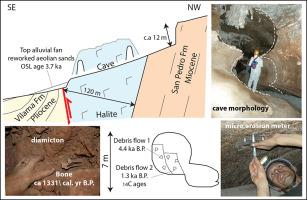当前位置:
X-MOL 学术
›
Geomorphology
›
论文详情
Our official English website, www.x-mol.net, welcomes your
feedback! (Note: you will need to create a separate account there.)
Holocene evolution of halite caves in the Cordillera de la Sal (Central Atacama, Chile) in different climate conditions
Geomorphology ( IF 3.1 ) Pub Date : 2020-12-01 , DOI: 10.1016/j.geomorph.2020.107398 Jo De Waele , Vincenzo Picotti , Mario L.V. Martina , George Brook , Linhai Yang , Paolo Forti
Geomorphology ( IF 3.1 ) Pub Date : 2020-12-01 , DOI: 10.1016/j.geomorph.2020.107398 Jo De Waele , Vincenzo Picotti , Mario L.V. Martina , George Brook , Linhai Yang , Paolo Forti

|
Abstract Geomorphological studies have been carried out in rapidly evolving salt caves related to small watersheds in the San Pedro de Atacama area, Chile. Radiocarbon ages of bones and wood from cave deposits, combined with the presence of large salt caves, geomorphological and sedimentological observations, and the results of micrometer measurements outside and in some of the caves, suggest a period of speleogenesis in the Cordillera de la Sal during the onset of the Holocene, during which the large halite cave systems developed, followed by an early Holocene hyperarid period. Most smaller caves (i.e. Lechuza del Campanario) most probably formed at the start of the wetter mid-Holocene period (5–4.4 ka), when precipitation was never intense enough to entrain large amounts of sediments, but enough to trigger cave development. A diamicton in Lechuza del Campanario Cave radiocarbon dated at ca. 4.4 ka shows that at least one high intensity rainfall event occurred in this recharge basin during the mid-Holocene wet interval. A wet period with lower intensity rainfall events followed between 4.0 and 2.5 ka, causing the 4.4 kyrs old diamicton in Lechuza del Campanario Cave to be entrenched, and the alluvial fan at the downstream end of Palacio del Sal Cave to be covered with windborne sediments dated by OSL at around 3.6 ka. At ca. 2 ka there was a high-intensity rainfall event documented by the age of a twig stuck in the ceiling of the Palacio del Sal Cave, followed by a period with lower intensity rain events until ca. 1.3 ka, when another intense flood produced a mudflow that deposited a second diamicton in Lechuza del Campanario Cave. From then on clustering of radiocarbon ages for wood and bone recovered from caves indicates increased rainfall intensity in the period ca. 0.9–0.5 ka, followed by no registered events until a minor flood at ca. 0.13 ka. The four-centuries long wetter time interval (0.9–0.5 ka), corresponding to the Medieval Climate Anomaly, has been an archeologically important period in the Atacama Desert (Tiwanaku culture). The observations and a detailed review of paleoclimate literature from this key area have allowed the development of a landscape evolution model related to changing climate conditions during the Late Holocene.
中文翻译:

不同气候条件下 Cordillera de la Sal(智利阿塔卡马中部)岩盐洞穴的全新世演化
摘要 在智利圣佩德罗德阿塔卡马地区与小流域相关的快速演变的盐洞中进行了地貌学研究。来自洞穴沉积物的骨骼和木材的放射性碳年龄,结合大型盐洞的存在、地貌和沉积学观察,以及一些洞穴外部和内部的测微仪测量结果,表明 Cordillera de la Sal 在全新世开始,在此期间发展了大型岩盐洞穴系统,随后是早期全新世超干旱时期。大多数较小的洞穴(即 Lechuza del Campanario)最有可能在潮湿的全新世中期(5-4.4 ka)开始时形成,当时降水的强度从未足以夹带大量沉积物,但足以引发洞穴发展。Lechuza del Campanario 洞穴放射性碳中的一个diamicton 日期为大约。4.4 ka 表明,在全新世中期湿润间隔期间,该补给盆地至少发生了一次高强度降雨事件。随后在 4.0 至 2.5 ka 之间出现了一个降雨强度较低的潮湿期,导致 Lechuza del Campanario 洞穴中 4.4 kyrs 的旧diamicton 被根深蒂固,Palacio del Sal 洞穴下游端的冲积扇被风载沉积物覆盖由 OSL 大约 3.6 ka。在大约 2 ka 有一个高强度的降雨事件记录在一个树枝的年龄卡在 Palacio del Sal 洞穴的天花板上,然后是一个强度较低的降雨事件,直到大约 2000 年。1.3 ka,当另一场强烈的洪水产生泥石流,在 Lechuza del Campanario 洞穴中沉积了第二个diamicton。从那时起,从洞穴中回收的木材和骨骼的放射性碳年龄聚类表明大约在该时期降雨强度增加。0.9–0.5 ka,随后没有记录事件,直到大约发生小洪水。0.13 卡。与中世纪气候异常相对应的长达四个世纪的湿润时间间隔(0.9-0.5 ka)一直是阿塔卡马沙漠(蒂瓦纳库文化)考古学上的重要时期。对这一关键区域的古气候文献的观察和详细审查,使得与全新世晚期气候条件变化相关的景观演化模型得以发展。9–0.5 ka),对应于中世纪气候异常,是阿塔卡马沙漠(蒂瓦纳库文化)的考古学重要时期。对这一关键区域的古气候文献的观察和详细审查,使得与全新世晚期气候条件变化相关的景观演化模型得以发展。9–0.5 ka),对应于中世纪气候异常,是阿塔卡马沙漠(蒂瓦纳库文化)的考古学重要时期。对这一关键区域的古气候文献的观察和详细审查,使得与全新世晚期气候条件变化相关的景观演化模型得以发展。
更新日期:2020-12-01
中文翻译:

不同气候条件下 Cordillera de la Sal(智利阿塔卡马中部)岩盐洞穴的全新世演化
摘要 在智利圣佩德罗德阿塔卡马地区与小流域相关的快速演变的盐洞中进行了地貌学研究。来自洞穴沉积物的骨骼和木材的放射性碳年龄,结合大型盐洞的存在、地貌和沉积学观察,以及一些洞穴外部和内部的测微仪测量结果,表明 Cordillera de la Sal 在全新世开始,在此期间发展了大型岩盐洞穴系统,随后是早期全新世超干旱时期。大多数较小的洞穴(即 Lechuza del Campanario)最有可能在潮湿的全新世中期(5-4.4 ka)开始时形成,当时降水的强度从未足以夹带大量沉积物,但足以引发洞穴发展。Lechuza del Campanario 洞穴放射性碳中的一个diamicton 日期为大约。4.4 ka 表明,在全新世中期湿润间隔期间,该补给盆地至少发生了一次高强度降雨事件。随后在 4.0 至 2.5 ka 之间出现了一个降雨强度较低的潮湿期,导致 Lechuza del Campanario 洞穴中 4.4 kyrs 的旧diamicton 被根深蒂固,Palacio del Sal 洞穴下游端的冲积扇被风载沉积物覆盖由 OSL 大约 3.6 ka。在大约 2 ka 有一个高强度的降雨事件记录在一个树枝的年龄卡在 Palacio del Sal 洞穴的天花板上,然后是一个强度较低的降雨事件,直到大约 2000 年。1.3 ka,当另一场强烈的洪水产生泥石流,在 Lechuza del Campanario 洞穴中沉积了第二个diamicton。从那时起,从洞穴中回收的木材和骨骼的放射性碳年龄聚类表明大约在该时期降雨强度增加。0.9–0.5 ka,随后没有记录事件,直到大约发生小洪水。0.13 卡。与中世纪气候异常相对应的长达四个世纪的湿润时间间隔(0.9-0.5 ka)一直是阿塔卡马沙漠(蒂瓦纳库文化)考古学上的重要时期。对这一关键区域的古气候文献的观察和详细审查,使得与全新世晚期气候条件变化相关的景观演化模型得以发展。9–0.5 ka),对应于中世纪气候异常,是阿塔卡马沙漠(蒂瓦纳库文化)的考古学重要时期。对这一关键区域的古气候文献的观察和详细审查,使得与全新世晚期气候条件变化相关的景观演化模型得以发展。9–0.5 ka),对应于中世纪气候异常,是阿塔卡马沙漠(蒂瓦纳库文化)的考古学重要时期。对这一关键区域的古气候文献的观察和详细审查,使得与全新世晚期气候条件变化相关的景观演化模型得以发展。











































 京公网安备 11010802027423号
京公网安备 11010802027423号